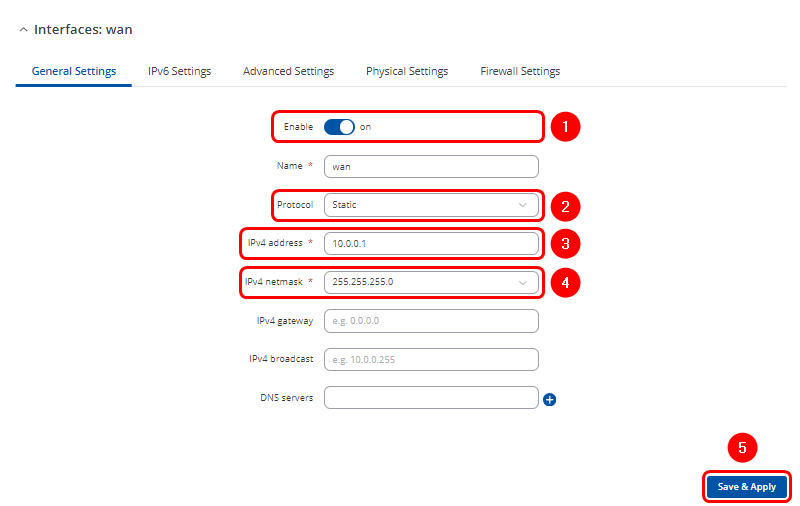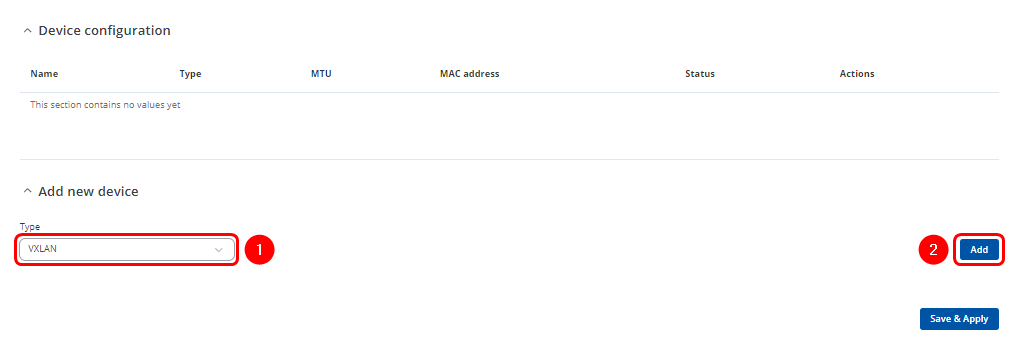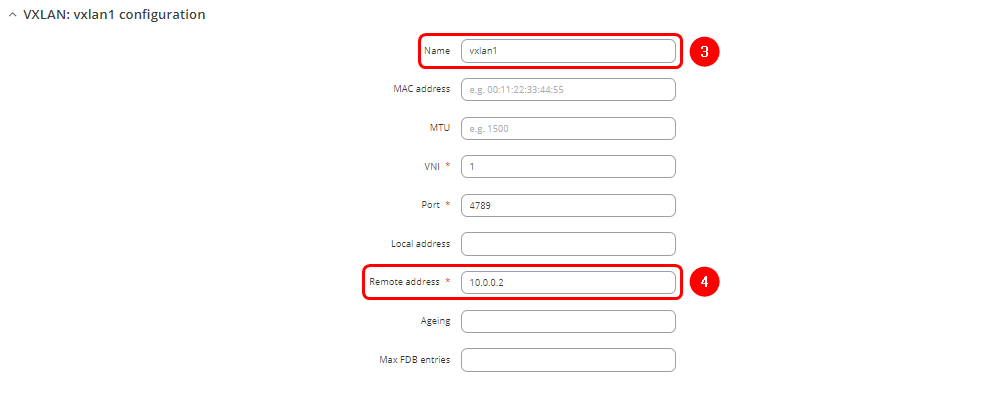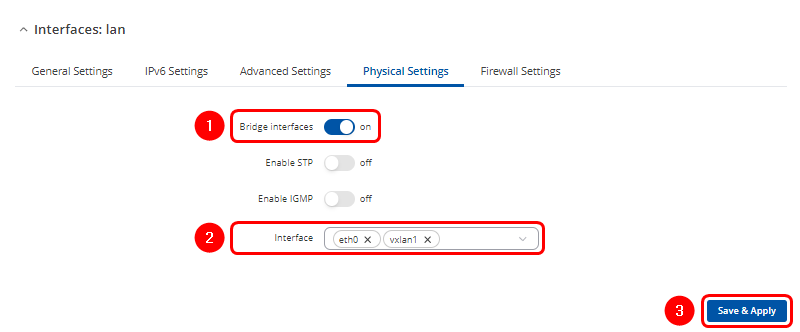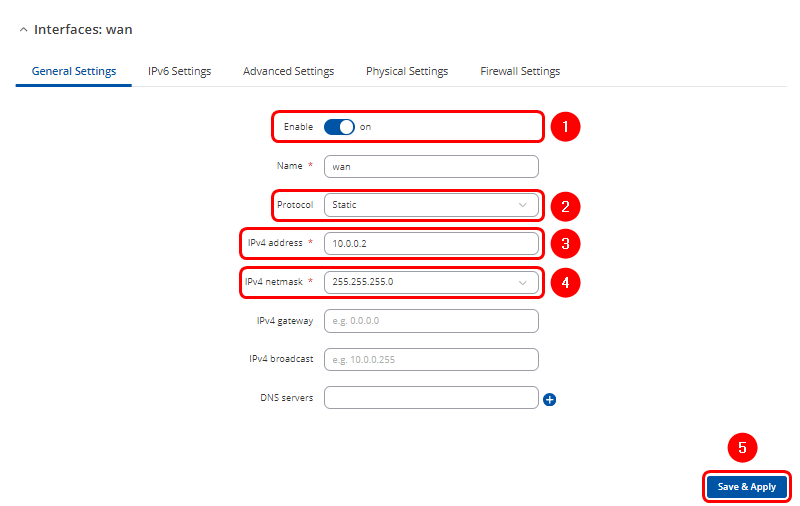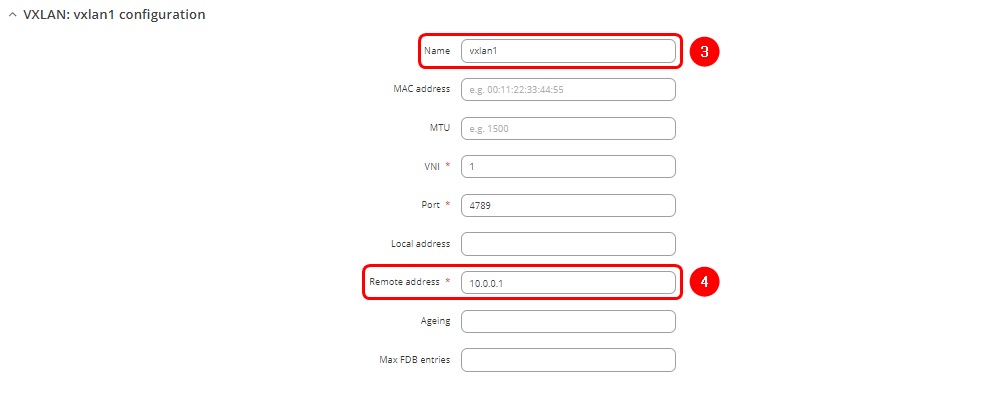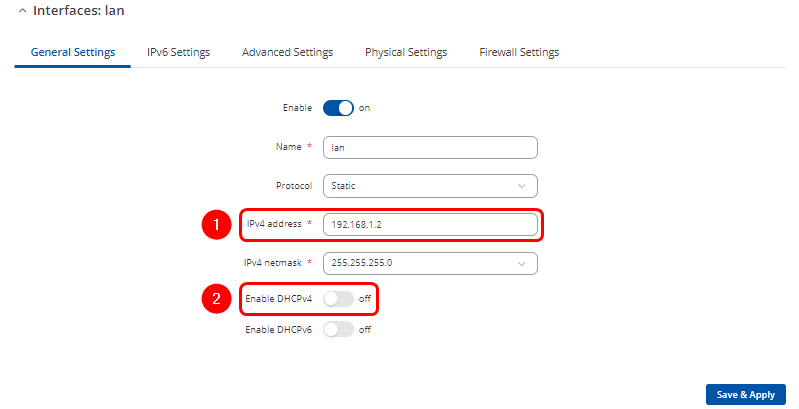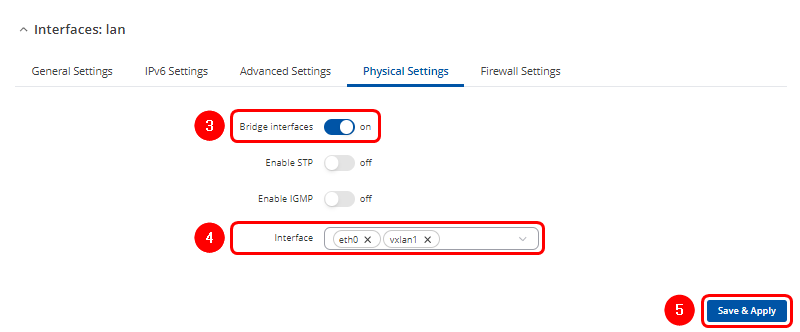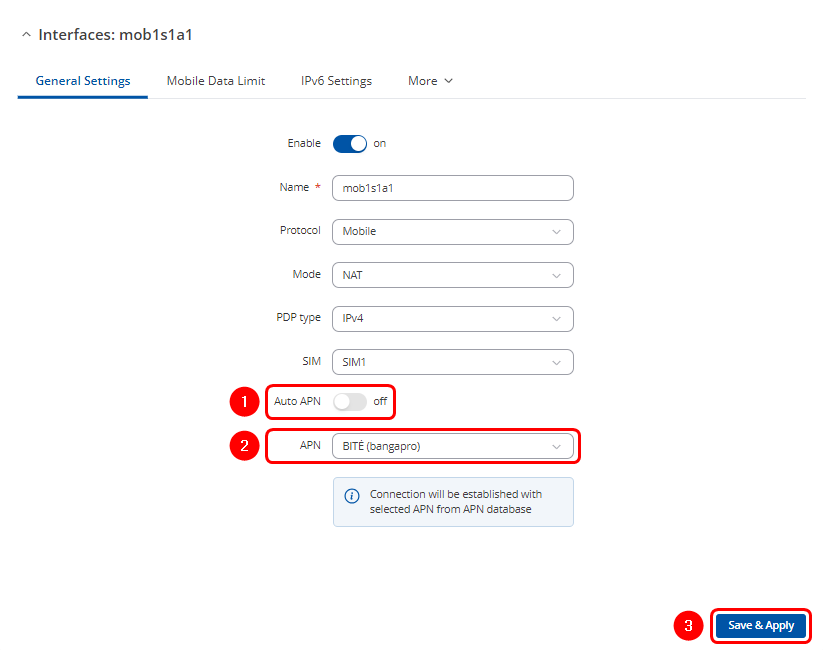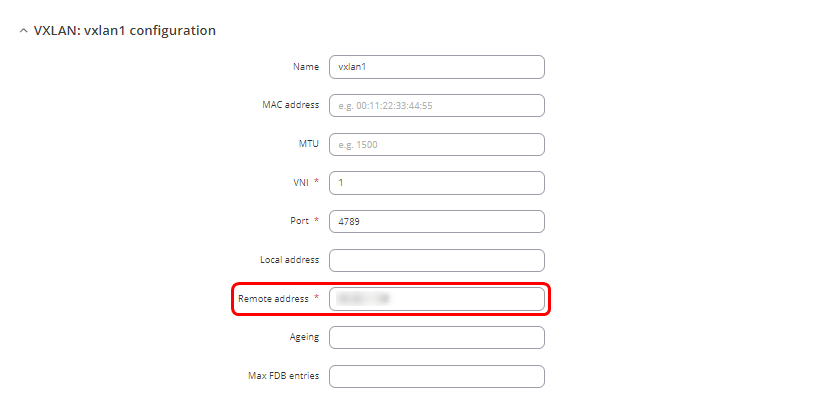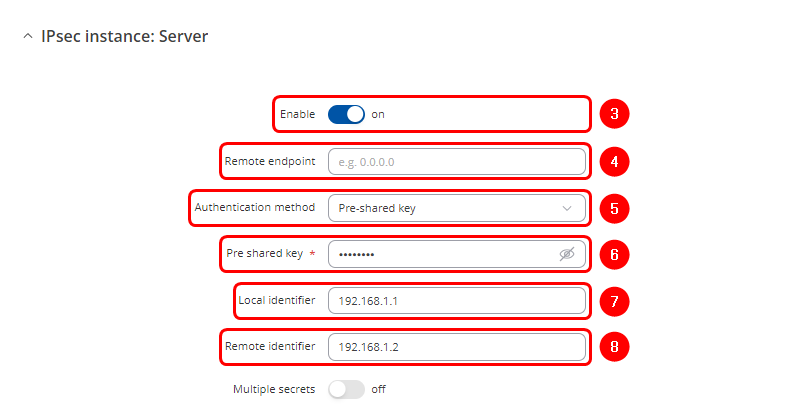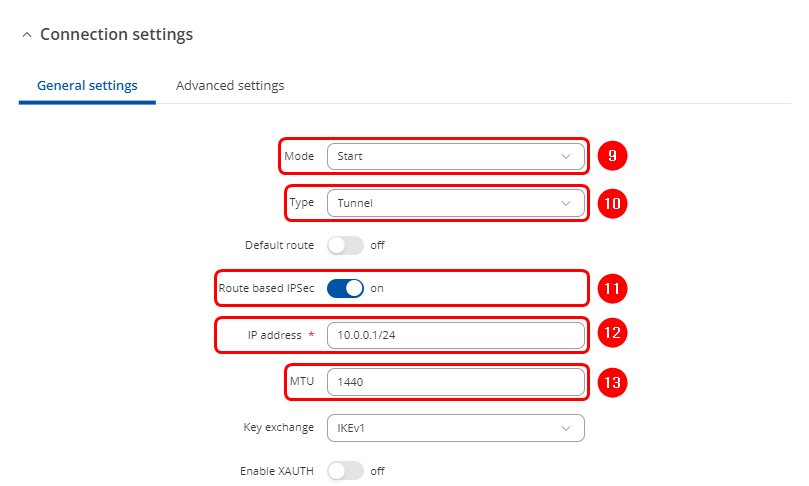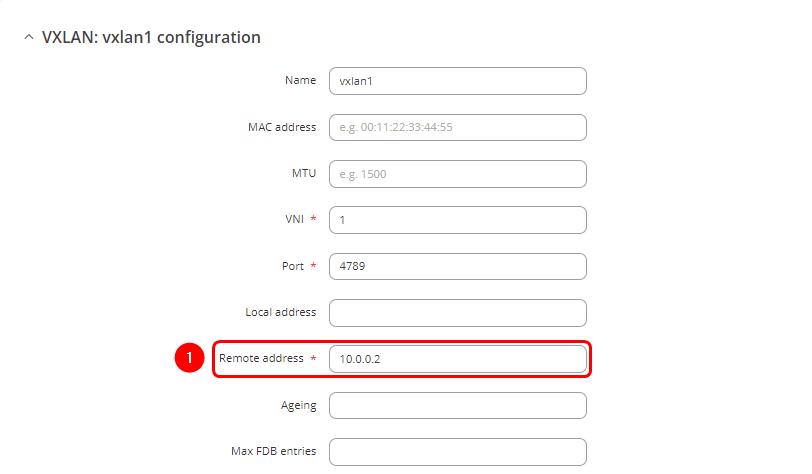Difference between revisions of "VXLAN Configuration Example"
| (39 intermediate revisions by the same user not shown) | |||
| Line 1: | Line 1: | ||
''VXLAN support has been introduced starting with firmware version 00.07.09 and later. It is advised to update to the latest firmware available. | ''VXLAN support has been introduced starting with firmware version 00.07.09 and later. It is advised to update to the latest firmware available. | ||
'' | '' | ||
| − | <p style="color:red">The information in this page is updated in accordance with [https://firmware.teltonika-networks.com/7.9.1/RUTX/RUTX_R_00.07.09.1_WEBUI.bin'''00.07.09. | + | <p style="color:red">The information in this page is updated in accordance with [https://firmware.teltonika-networks.com/7.9.1/RUTX/RUTX_R_00.07.09.1_WEBUI.bin'''00.07.09.1'''] firmware version.</p> |
==Introduction== | ==Introduction== | ||
| Line 17: | Line 17: | ||
Navigate to '''System > Package Manager''' | Navigate to '''System > Package Manager''' | ||
| − | #In the search bar look for | + | #In the search bar look for vxlan packet |
#Click '''Install''' | #Click '''Install''' | ||
[[File:Vxlan package manager installation.png|border|class=tlt-border]] | [[File:Vxlan package manager installation.png|border|class=tlt-border]] | ||
| Line 25: | Line 25: | ||
===Configuration on RUT1 device=== | ===Configuration on RUT1 device=== | ||
---- | ---- | ||
| − | Navigate to the '''Network > WAN''' section in the WebUI, then click the | + | Navigate to the '''Network > WAN''' section in the WebUI, then click the '''Edit''' button for the wired WAN interface. |
[[File:Vxlan_over_wan_config_rut1_wan_p1.png|border|class=tlt-border]] | [[File:Vxlan_over_wan_config_rut1_wan_p1.png|border|class=tlt-border]] | ||
| Line 41: | Line 41: | ||
[[File:Vxlan over wired vxlan settings add.png|border|class=tlt-border]] | [[File:Vxlan over wired vxlan settings add.png|border|class=tlt-border]] | ||
#<li value="3">Enter name of the new VXLAN interface | #<li value="3">Enter name of the new VXLAN interface | ||
| − | + | # Enter the Remote address corresponding to RUT2 wired WAN interface IP address | |
| − | |||
| − | #Enter the Remote address corresponding to RUT2 wired WAN interface IP address | ||
# Click [[File:Save & Apply.png|90px]] twice | # Click [[File:Save & Apply.png|90px]] twice | ||
| − | [[File:Vxlan over wired vxlan rut1 | + | [[File:Vxlan over wired vxlan settings rut1.png|border|class=tlt-border]] |
| − | Navigate to '''Network > LAN''' and click | + | Navigate to '''Network > LAN''' and click '''Edit''' to modify existing LAN interface |
[[File:Vxlan over wired lan config.png|border|class=tlt-border]] | [[File:Vxlan over wired lan config.png|border|class=tlt-border]] | ||
| − | |||
#Asure that '''Bridge interfaces''' option is enabled | #Asure that '''Bridge interfaces''' option is enabled | ||
| − | #Click on the droplist and add | + | #Click on the droplist and add vxlan1 interface |
#Click [[File:Save & Apply.png|90px]] twice | #Click [[File:Save & Apply.png|90px]] twice | ||
| Line 61: | Line 58: | ||
---- | ---- | ||
| − | The configuration steps for RUT2 are similar to those performed on RUT1, with some additional adjustments. Navigate to the '''Network > WAN''' section in the WebUI, then click the | + | The configuration steps for RUT2 are similar to those performed on RUT1, with some additional adjustments. Navigate to the '''Network > WAN''' section in the WebUI, then click the '''Edit''' button for the wired WAN interface. |
[[File:Vxlan_over_wan_config_rut1_wan_p1.png|border|class=tlt-border]] | [[File:Vxlan_over_wan_config_rut1_wan_p1.png|border|class=tlt-border]] | ||
| Line 76: | Line 73: | ||
#Press [[File:Add Button.png|50px]] | #Press [[File:Add Button.png|50px]] | ||
[[File:Vxlan over wired vxlan settings add.png|border|class=tlt-border]] | [[File:Vxlan over wired vxlan settings add.png|border|class=tlt-border]] | ||
| − | |||
#<li value="3">Enter name of the new VXLAN interface | #<li value="3">Enter name of the new VXLAN interface | ||
| − | + | #Enter the Remote address corresponding to RUT1 wired WAN interface IP address | |
| − | |||
| − | #Enter the Remote address corresponding to | ||
#Click [[File:Save & Apply.png|90px]] twice | #Click [[File:Save & Apply.png|90px]] twice | ||
| − | [[File:Vxlan over wired vxlan rut2 | + | [[File:Vxlan over wired vxlan settings rut2.jpg|border|class=tlt-border]] |
| − | Navigate to '''Network > LAN''' and click | + | Navigate to '''Network > LAN''' and click '''Edit''' to modify existing LAN interface. |
[[File:Vxlan over wired lan config rut2.png|border|class=tlt-border]] | [[File:Vxlan over wired lan config rut2.png|border|class=tlt-border]] | ||
| − | #For testing purposes, both routers should be part of the same LAN segment, so assign unique IP addresses to prevent conflicts | + | #For testing purposes, both routers should be part of the same LAN segment, so assign unique IP addresses to prevent conflicts. |
| − | #Additionally, | + | #Additionally, only one DHCP server, so disable DHCP on RUT2. |
[[File:Vxlan over wired lan settings RUT2.png|border|class=tlt-border]] | [[File:Vxlan over wired lan settings RUT2.png|border|class=tlt-border]] | ||
| − | + | #<li value="3">Asure that Bridge interfaces option is enabled | |
| − | |||
| − | #<li value="3">Asure that | ||
#Click on the droplist and add vxlan1 interface | #Click on the droplist and add vxlan1 interface | ||
#Click [[File:Save & Apply.png|90px]] twice | #Click [[File:Save & Apply.png|90px]] twice | ||
| Line 99: | Line 91: | ||
In this section, VXLAN will be set up between two Teltonika devices using Mobile WAN, requiring two public IPs—one for each RUT device. The configuration steps will be similar to those described in the [[#VXLAN over Wired WAN|VXLAN over Wired WAN]] section of this page, except for the '''APN''' settings and the '''Network > Devices''' section settings, where the remote address of the created VXLAN interface will be updated to reflect the other router's public IP. | In this section, VXLAN will be set up between two Teltonika devices using Mobile WAN, requiring two public IPs—one for each RUT device. The configuration steps will be similar to those described in the [[#VXLAN over Wired WAN|VXLAN over Wired WAN]] section of this page, except for the '''APN''' settings and the '''Network > Devices''' section settings, where the remote address of the created VXLAN interface will be updated to reflect the other router's public IP. | ||
| − | === | + | ===Configuration on RUT1 device=== |
---- | ---- | ||
| − | + | Navigate to the '''Network > WAN''' section in the WebUI, then click the '''Edit''' button for the mobile WAN interface. | |
| − | |||
| − | |||
| − | Navigate to the '''Network > WAN''' section in the WebUI, then click the | ||
[[File:Vxlan over mobile wan config rut1 rev2.png|border|class=tlt-border]] | [[File:Vxlan over mobile wan config rut1 rev2.png|border|class=tlt-border]] | ||
| − | :Configuration window will open. Adjust | + | :Configuration window will open. Adjust following: |
#Disable '''Auto APN''' | #Disable '''Auto APN''' | ||
| − | #Select an APN that will provide your router with a | + | #Select an APN that will provide your router with a public IP |
# Click [[File:Save & Apply.png|90px]] twice | # Click [[File:Save & Apply.png|90px]] twice | ||
[[File:Vxlan over mobile wan config rut1 2.png|border|class=tlt-border]] | [[File:Vxlan over mobile wan config rut1 2.png|border|class=tlt-border]] | ||
| − | + | Navigate to the '''Network > Devices'''. If configuring new instance click Add, if editing existing interface from before, click Edit | |
| − | + | #In '''Remote address''' section, instead of wired WAN IP, '''RUT2 Public IP''' address will be used | |
| − | |||
| − | Navigate to '''Network > Devices'''. | ||
| − | |||
| − | #In '''Remote address''' section | ||
# Click [[File:Save & Apply.png|90px]] twice | # Click [[File:Save & Apply.png|90px]] twice | ||
| Line 125: | Line 110: | ||
===Configuration on RUT2 device=== | ===Configuration on RUT2 device=== | ||
---- | ---- | ||
| + | Navigate to the '''Network > WAN''' section in the WebUI, then click the '''Edit''' button for the mobile WAN interface. | ||
| + | [[File:Vxlan over mobile wan config rut1 rev2.png|border|class=tlt-border]] | ||
| − | + | :Configuration window will open. Adjust following: | |
| + | #Disable '''Auto APN''' | ||
| + | #Select an APN that will provide your router with a public IP | ||
| + | # Click [[File:Save & Apply.png|90px]] twice | ||
| + | [[File:Vxlan over mobile wan config rut1 2.png|border|class=tlt-border]] | ||
| − | #In '''Remote address''' section | + | Navigate to the '''Network > Devices''' |
| + | #In '''Remote address''' section, instead of wired WAN IP, '''RUT1 Public IP''' address will be used | ||
# Click [[File:Save & Apply.png|90px]] twice | # Click [[File:Save & Apply.png|90px]] twice | ||
| Line 134: | Line 126: | ||
==VXLAN over VPN tunnel== | ==VXLAN over VPN tunnel== | ||
| − | + | File:Vxlan over vpn add server.png | |
| − | + | If only one public IP address is available, VXLAN can be configured through a VPN tunnel. In this case, an IPsec VPN will be used, where RUT1 acts as the VPN server and RUT2 as the client. The VPN creates remote tunnel endpoints, which can then be integrated into the VXLAN configuration to enable Layer 2 communication between the routers. | |
| − | If only one | ||
| − | |||
| − | |||
===Configuration on RUT1 device=== | ===Configuration on RUT1 device=== | ||
| Line 164: | Line 153: | ||
| − | Navigate to '''Network > Devices''' | + | Navigate to '''Network > Devices''' and click '''Edit''' to adjust VXLAN interface settings: |
| − | + | #Enter IP address of RUT2 VPN tunnel endpoint | |
| − | #Enter | ||
#Click the [[File:Save & Apply.png|90px]] twice | #Click the [[File:Save & Apply.png|90px]] twice | ||
| − | |||
[[File:Vxlan over vpn vxlan settings rut1.png|border|class=tlt-border]] | [[File:Vxlan over vpn vxlan settings rut1.png|border|class=tlt-border]] | ||
===Configuration on RUT2 device=== | ===Configuration on RUT2 device=== | ||
---- | ---- | ||
| − | |||
#Enter Instance name | #Enter Instance name | ||
#Click on the [[File:Add Button.png|50px]] | #Click on the [[File:Add Button.png|50px]] | ||
[[File:Vxlan over vpn add client.png|border|class=tlt-border]] | [[File:Vxlan over vpn add client.png|border|class=tlt-border]] | ||
| − | |||
| − | |||
| − | |||
| − | |||
| − | |||
| − | |||
| − | |||
| − | |||
| − | |||
| − | |||
| − | |||
| − | |||
| − | |||
| − | |||
| − | |||
| − | |||
| − | |||
| − | |||
| − | |||
| − | |||
| − | |||
| − | |||
| − | |||
| − | |||
| − | |||
==Configuration testing== | ==Configuration testing== | ||
Revision as of 14:29, 8 October 2024
VXLAN support has been introduced starting with firmware version 00.07.09 and later. It is advised to update to the latest firmware available.
The information in this page is updated in accordance with 00.07.09.1 firmware version.
Introduction
VXLAN (Virtual Extensible LAN) encapsulates Layer 2 Ethernet frames within Layer 3 packets, creating a Layer 2 network over a Layer 3 infrastructure. It acts as a virtual switch, interconnecting routers and all devices connected to them into an extended Layer 2 network, enhancing scalability and flexibility. In this article several methods to configure a VXLAN tunnel between two Teltonika devices will be demonstrated.
Prerequisites
- Two routers with installed VXLAN packages, will refer to these as RUT1 and RUT2
- End device like Laptop or Mobile Phone
- Two Public IP addresses for configuring VXLAN over the Mobile network
- One Public IP address for configuring VXLAN over the VPN tunnel
VXLAN package Installation
First, install the VXLAN package on both RUT1 and RUT2 devices. This package is available on firmware version 07.09 and later, therefore, updating the router's firmware is a mandatory step if it is outdated. After the update, the package can be found in the Package Manager in the WebUI.
Navigate to System > Package Manager
- In the search bar look for vxlan packet
- Click Install
VXLAN over Wired WAN
In this section, the setup of VXLAN over Wired WAN using RUT1 and RUT2 devices will be described. The process will show how to create a VXLAN tunnel to connect the devices and allow them to communicate over the wired network.
Configuration on RUT1 device
Navigate to the Network > WAN section in the WebUI, then click the Edit button for the wired WAN interface.

- Configuration window will open. Adjust following:
- Ensure interface is Enabled
- Change Protocol to Static
- Enter Ipv4 address for communication in this Wired WAN network
- Select your preferable IPv4 netmask
- Click
 twice
twice
Navigate to the Network > Devices
- Enter name of the new VXLAN interface
- Enter the Remote address corresponding to RUT2 wired WAN interface IP address
- Click
 twice
twice
Navigate to Network > LAN and click Edit to modify existing LAN interface
- Asure that Bridge interfaces option is enabled
- Click on the droplist and add vxlan1 interface
- Click
 twice
twice
Configuration on RUT2 device
The configuration steps for RUT2 are similar to those performed on RUT1, with some additional adjustments. Navigate to the Network > WAN section in the WebUI, then click the Edit button for the wired WAN interface.

Configuration window will open. Adjust following:
- Ensure interface is Enabled
- Change Protocol to Static
- Enter Ipv4 address for communication in this Wired WAN network
- Select your preferable IPv4 netmask
- Click
 twice
twice
Navigate to the Network > Devices
- Enter name of the new VXLAN interface
- Enter the Remote address corresponding to RUT1 wired WAN interface IP address
- Click
 twice
twice
Navigate to Network > LAN and click Edit to modify existing LAN interface.

- For testing purposes, both routers should be part of the same LAN segment, so assign unique IP addresses to prevent conflicts.
- Additionally, only one DHCP server, so disable DHCP on RUT2.
- Asure that Bridge interfaces option is enabled
- Click on the droplist and add vxlan1 interface
- Click
 twice
twice
VXLAN over Mobile network
In this section, VXLAN will be set up between two Teltonika devices using Mobile WAN, requiring two public IPs—one for each RUT device. The configuration steps will be similar to those described in the VXLAN over Wired WAN section of this page, except for the APN settings and the Network > Devices section settings, where the remote address of the created VXLAN interface will be updated to reflect the other router's public IP.
Configuration on RUT1 device
Navigate to the Network > WAN section in the WebUI, then click the Edit button for the mobile WAN interface.

- Configuration window will open. Adjust following:
Navigate to the Network > Devices. If configuring new instance click Add, if editing existing interface from before, click Edit
Configuration on RUT2 device
Navigate to the Network > WAN section in the WebUI, then click the Edit button for the mobile WAN interface.

- Configuration window will open. Adjust following:
Navigate to the Network > Devices
VXLAN over VPN tunnel
File:Vxlan over vpn add server.png If only one public IP address is available, VXLAN can be configured through a VPN tunnel. In this case, an IPsec VPN will be used, where RUT1 acts as the VPN server and RUT2 as the client. The VPN creates remote tunnel endpoints, which can then be integrated into the VXLAN configuration to enable Layer 2 communication between the routers.
Configuration on RUT1 device
Navigate to Services > VPN > IPsec:
- Enable instance
- Since RUT1 will serve as the server device, the Remote endpoint field should be left blank
- Select Pre-Shared Key as the authentication method
- Enter the key. This key must match the one that will be entered later in the RUT2 IPSec settings
- Enter the RUT1 LAN IP address as the Local identifier
- Enter the RUT2 LAN IP address as the Remote identifier
- Scroll down to Connection settings:
- Select "Start" in Mode section
- Select "Tunnel" as connection type
- Enable "Route based IPSec"
- Enter the IP address of the RUT1 tunnel endpoint
- Enter lower MTU to reduce packet size (optional)
- Leave all other settings at their default values and click the
 twice
twice
Navigate to Network > Devices and click Edit to adjust VXLAN interface settings:
Configuration on RUT2 device
Configuration testing
The best way to test the configuration after setting up VXLAN between the routers is to ping between devices on either side of the routers using their LAN IPs and check the ARP tables. This ensures that devices on the same LAN segment can communicate over the Layer 2 (L2) network through the routers.
Configuration testing from RUT1 side:
If the MAC address for the specified IP address in the ARP table matches the RUT2's MAC address, it confirms that the configuration is functioning correctly.


